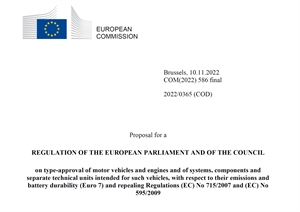European Commission proposes new Euro 7 standards for vehicles to cut pollution
Thu 10 November 2022
View all news

The European Commission has presented a proposal which it says will reduce air pollution from new motor vehicles sold in the EU. For the first time, the regulations introduce limits for non-exhaust particulate emissions from brakes and microplastic emissions from tyres.
The Commission says that Euro 7 and CO2 emission standards for vehicles work hand-in-hand to deliver air quality for citizens, notably through the uptake of electric vehicles.
With road transport the largest source of air pollution in cities the new Euro 7 emission standards aim to "ensure that cars, vans, lorries and buses are much cleaner, in real driving conditions that better reflect the situation in cities where air pollution problems are largest, and for a much longer period than under current rules".
Though CO2 emissions standards are helping to drive the uptake of electric vehicles, the Commission says that in 2050, more than 20% of cars and vans and more than half of the heavier vehicles in our streets are expected to still be emitting pollutants from the tailpipe. (The Commission notes that battery electric vehicles also still cause pollution from brakes and tyres.)
The Euro 7 standards rules bring emission limits for all motor vehicles, i.e., cars, vans, buses and lorries under a single set of rules. The new rules are fuel- and technology-neutral, placing the same limits regardless of whether the vehicle uses petrol, diesel, electric drive-trains or alternative fuels.
The new standards will be the first worldwide emission standards to move beyond regulating exhaust pipe emissions and set additional limits for non-exhaust particulate emissions from brakes and rules on microplastic emissions from tyres.
They will ensure that all vehicles will need to comply with the rules for a longer period than until now. Compliance for cars and vans will be checked until vehicles reach 200,000 kilometres and are 10 years old.
The Commission says that in 2035, Euro 7 will lower total NOx emissions from cars and vans by 35% compared to Euro 6, and by 56% compared to Euro VI from buses and lorries. At the same time, particles from the tailpipe will be lowered by 13% from cars and vans, and 39% from buses and lorries, while particles from the brakes of a car will be lowered by 27%.
Thierry Breton, Commissioner for Internal Market said: "To protect our climate, all new cars or vans placed on our market from 2035 will be zero-CO2 emissions. In addition to monitoring and supporting the fleet electrification, we are now tackling the emissions that aggravate air pollution and affect our health. With the Euro 7 rules we propose today, we will ensure that combustion engine cars put on our market until 2035, as well as heavy goods vehicles and electric vehicles, are as clean as possible for as long as possible, wherever they are used."
Martin Lundstedt, CEO of Volvo Group and Chairperson of ACEA’s Commercial Vehicle Board said: “To comply with Euro VII, truck makers will have to move substantial engineering and financial resources from battery and fuel-cell electric vehicles back to the internal combustion engine. This will severely impact our transition to zero-emission vehicles. It is not good for the climate, not good for people’s health and not good for the industry.”
A T&E spokesperson said: The Commission’s recently published Euro 7 proposal fails to deliver the ambition needed to tackle air pollution caused by road transport and meet newly revised EU Air Quality limits.
"Weak pollution limits for cars set 15 years ago remain largely unchanged, despite leaps in technological progress. This is particularly problematic for highly toxic nitrogen oxides (NOx) and particles which cause the majority of air pollution deaths. Truck particle limits were also weakened at the last minute in direct contradiction with expert recommendations."
Related Links
< Back to news list